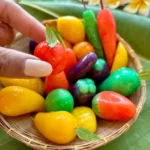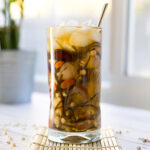Filipino desserts are a delightful mix of unique flavors and textures that showcase the rich culinary heritage of the Philippines. You’ll find a range of treats from sticky rice cakes to cool, refreshing ice-based desserts that are sure to satisfy your sweet tooth.
Each dessert tells a story of local ingredients and traditional cooking methods, offering a taste of Filipino culture with every bite. Whether you’re new to Filipino cuisine or looking to rediscover childhood favorites, these 25 desserts will introduce you to the sweet side of the Philippines.
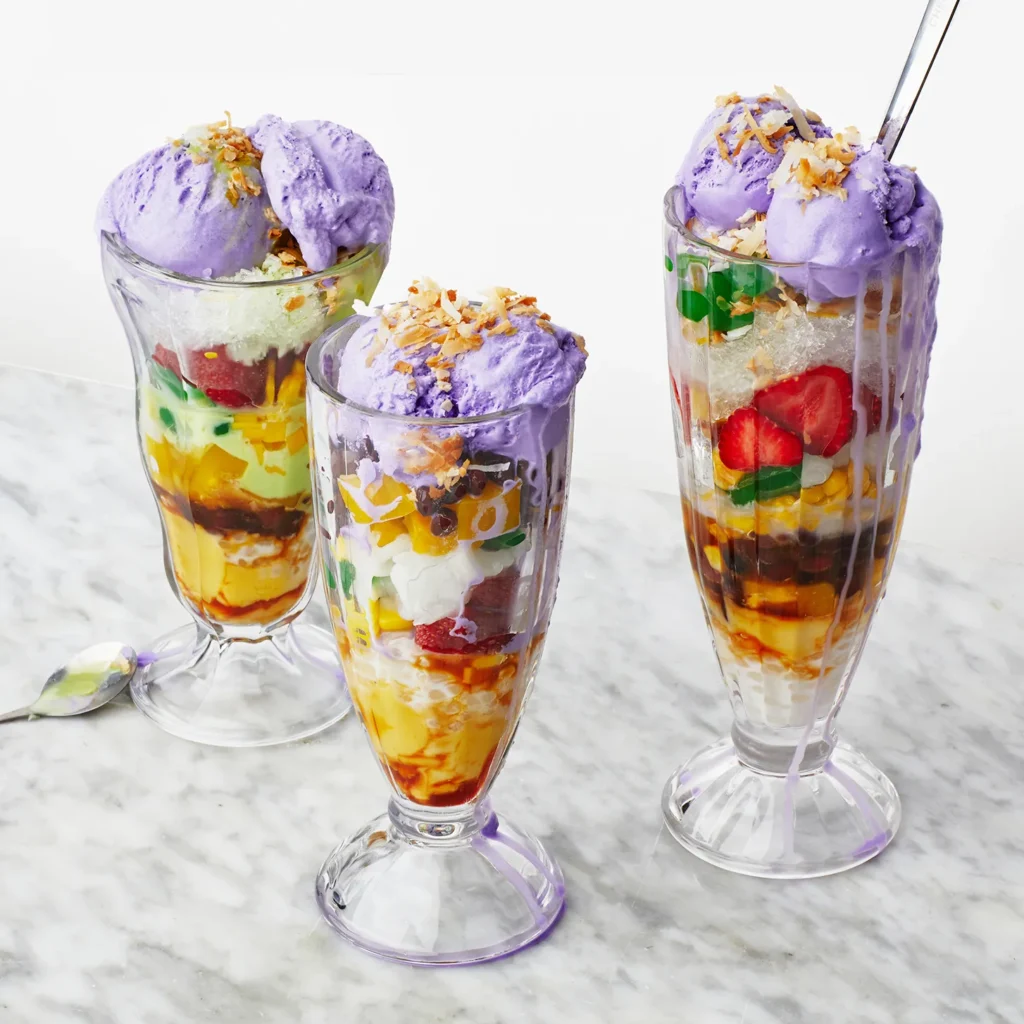
1) Halo-Halo
Halo-Halo is a popular Filipino dessert, perfect for hot days. It translates to “mix-mix”, highlighting the variety of ingredients used.
To prepare, start by layering sweetened fruits, jellies, and beans in a tall glass. Then, add shaved ice until the glass is almost full.
Next, drizzle evaporated milk over the ice. Top with a scoop of ice cream and a piece of leche flan. Optional toppings include nuts, rice crispies, or sliced plantains.
The mix of flavors and textures makes Halo-Halo unique. You’ll taste the sweetness of fruits blended with the creaminess of milk and ice cream. It’s a delightful experience with every bite.
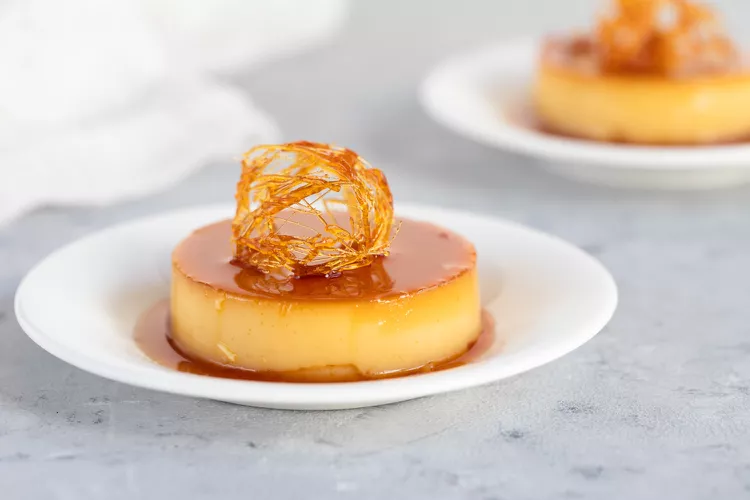
2) Leche Flan
Leche Flan is a popular Filipino dessert that is rich, smooth, and creamy. It is similar to crème caramel and has a layer of caramel sauce on top.
You usually make leche flan with egg yolks, condensed milk, evaporated milk, and vanilla. The ingredients are mixed together and poured into a mold called a llanera.
The caramel layer is created by melting sugar in a llanera until it turns golden brown. You need to distribute the melted sugar evenly on the bottom of the mold before adding the egg mixture.
To cook leche flan, you can either steam or bake it. When steaming, you place the mold in a steamer and cook until set. For baking, the flan is placed in a water bath and cooked until firm but still slightly jiggly.
The ideal flan has a wobbly texture but holds its shape when sliced. The caramel should be a clear layer of sauce that flows smoothly over the flan when served.
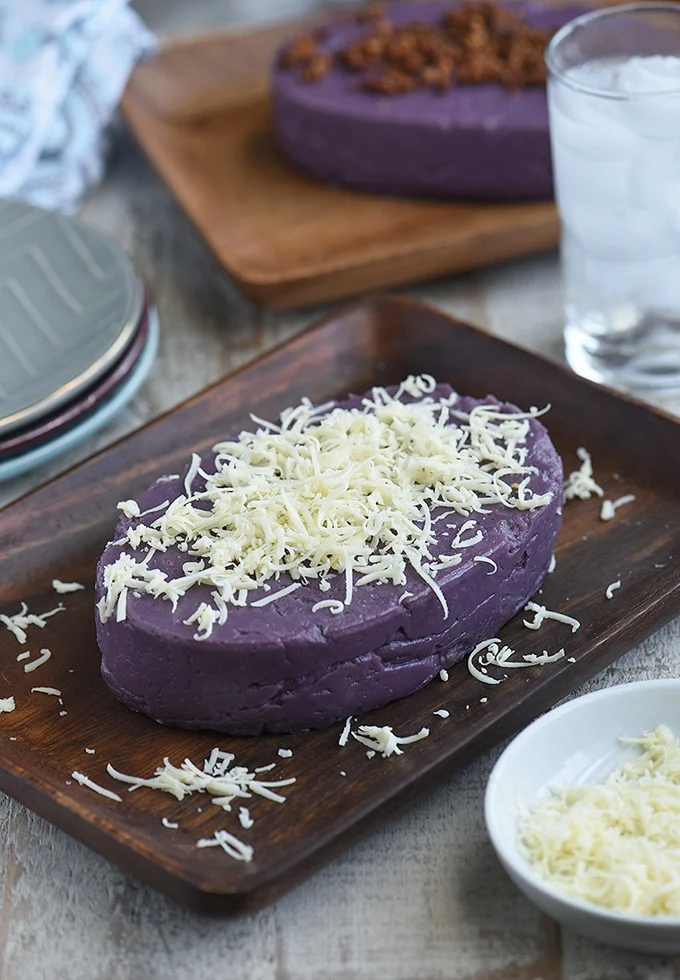
3) Ube Halaya
Ube Halaya, also known as purple yam jam, is a popular Filipino dessert known for its vibrant purple color and creamy texture.
To make Ube Halaya, you start by cooking grated purple yam with coconut milk, condensed milk, evaporated milk, butter, and sugar. The combination of these ingredients creates a rich and sweet taste.
You need to cook the mixture over medium heat, stirring constantly. This ensures that the ingredients blend well and the mixture thickens properly. It usually takes about 30 to 40 minutes.
Once thick and sticky, pour the mixture into molds or a baking dish. Let it cool down to room temperature before serving. You can enjoy it as is or top it with shredded cheese or coconut curds (latik) for added flavor.
Ube Halaya can also be used as a base for other desserts like Ube ice cream or cakes. Its unique flavor and versatility make it a beloved treat in many Filipino households.
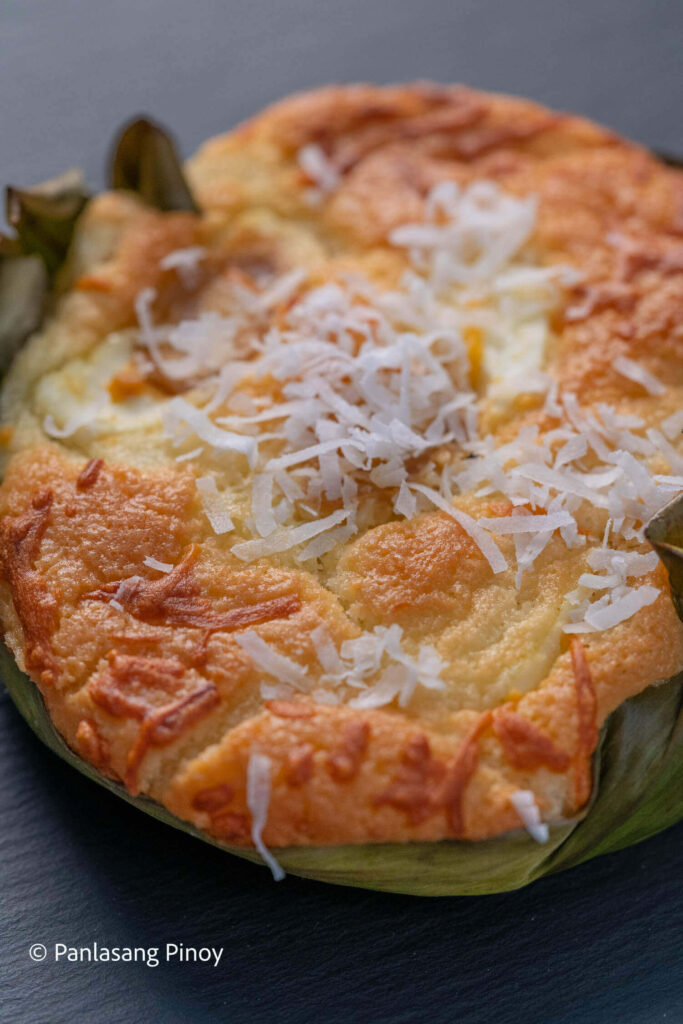
4) Bibingka
Bibingka is a beloved Filipino dessert that shines during the Christmas season. It’s a type of rice cake that combines glutinous rice flour, coconut milk, and sugar.
Bibingka typically has a soft, spongy texture. It’s often baked in a clay pot lined with banana leaves, which adds a unique fragrance.
Common toppings include slices of salted egg and grated cheese. These add a savory contrast to the sweet cake, making each bite unique and flavorful.
You can also find variations that include shredded coconut or butter brushed on top. Some versions even add a twist with ingredients like macapuno or more exotic flavors.
Enjoy this traditional treat with a warm beverage or as a festive breakfast option. Its simplicity and rich flavors make bibingka a must-try for anyone exploring Filipino cuisine.
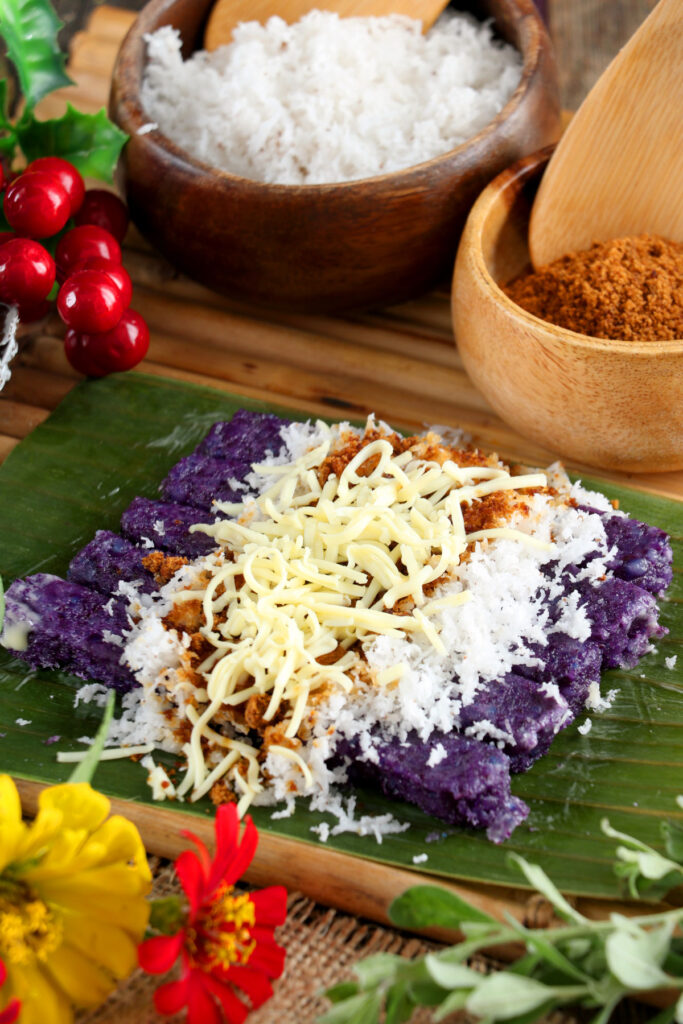
5) Puto Bumbong
Puto Bumbong is a traditional Filipino dessert often served during the Christmas season. Its unique purple color comes from the use of purple glutinous rice, which is soaked and ground into a fine consistency.
The rice mixture is then packed into bamboo tubes and steamed. This method gives Puto Bumbong its distinctive shape and texture.
Once steamed, Puto Bumbong is typically served on banana leaves. It is topped with freshly grated coconut, butter or margarine, and a sprinkle of sugar. Sometimes, it’s also garnished with cheese.
To make Puto Bumbong at home, you might substitute purple yam powder if you can’t find purple glutinous rice. You mix this with glutinous rice flour and water to form a dough, which you then steam in small foil containers if bamboo tubes are not available.
Enjoy this delightful treat by sharing it with friends and family, bringing a piece of Filipino festivity to your table.
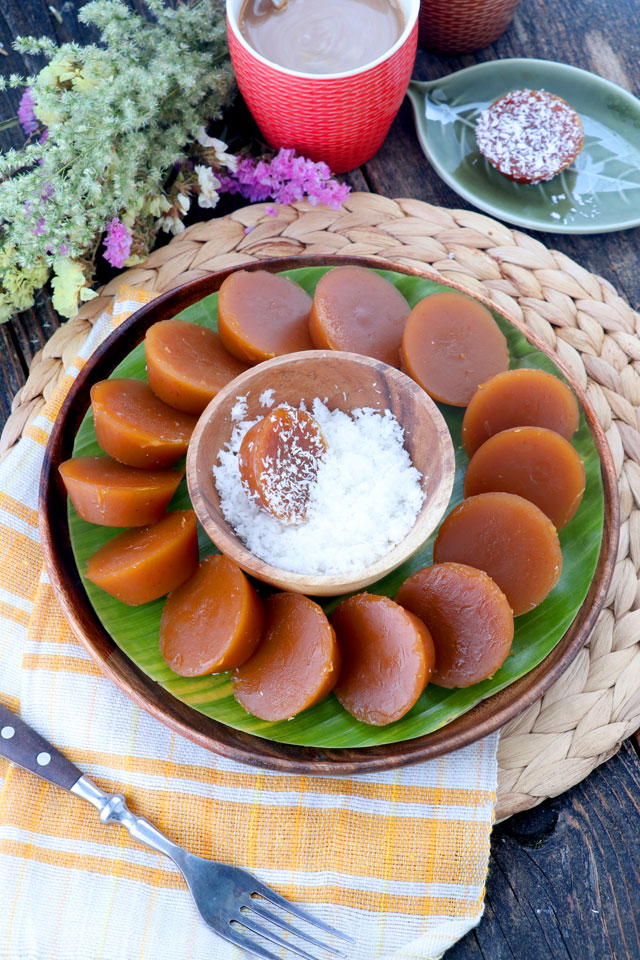
6) Kutsinta
Kutsinta is a popular Filipino steamed rice cake. It’s often served as a snack or dessert.
The cake is chewy and has a distinct orange color. This color comes from annatto seeds or atsuete powder.
To make Kutsinta, you combine ingredients like all-purpose flour, tapioca flour, and brown sugar. Add water and mix until smooth.
You also need lye water, which helps give Kutsinta its chewy texture.
Pour the mixture into molds. Traditionally, silicone or plastic molds are used.
Steam the mixture for about 40 minutes to an hour.
Once cooked, serve your Kutsinta with grated coconut on top. This adds a nice contrast to its chewy texture.
Kutsinta is a crowd-pleaser at Filipino gatherings. It’s loved by both kids and adults.
You can often find it sold by street vendors or in local markets.
This dessert is a great way to experience Filipino flavors and traditions. Enjoy your Kutsinta fresh and warm!
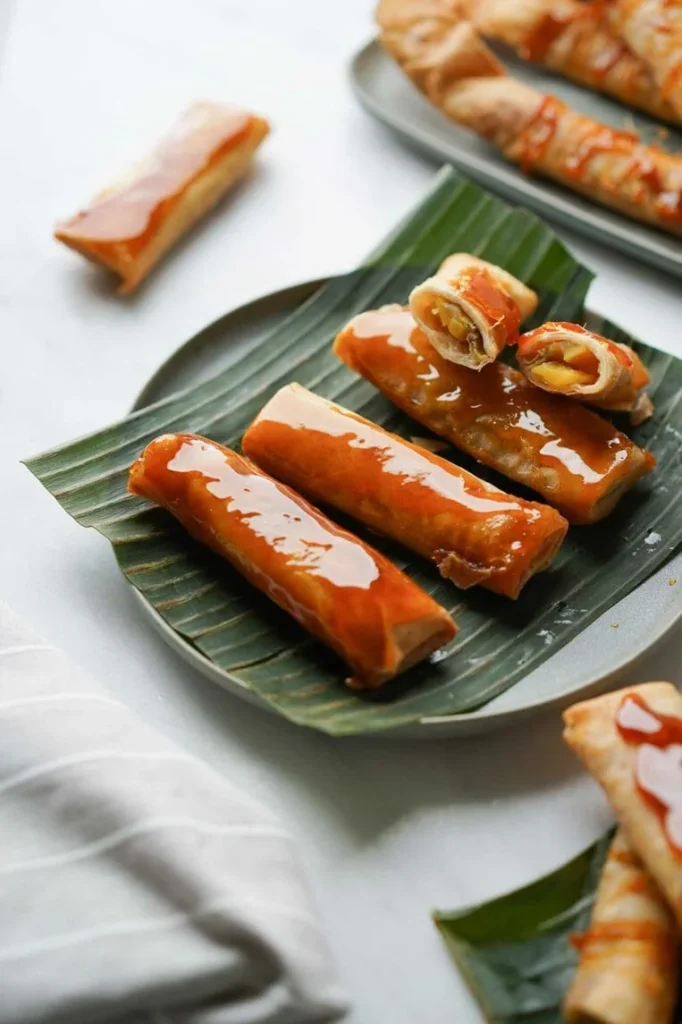
7) Turon
Turon is a popular Filipino dessert that features ripe bananas and sometimes jackfruit. These ingredients are wrapped in a spring roll wrapper.
To make turon, start by laying a spring roll wrapper flat. Place a quartered banana or a slice of jackfruit on it. Roll the wrapper tightly around the fruit, sealing the edges with water.
For frying, heat oil in a deep pan and add a little sugar. Let the sugar melt and float to the top. Fry the wrapped turon until the wrapper is golden brown and the sugar sticks to it.
For a baked version, preheat your oven to 400°F (200°C). Brush the wrapped turon with melted butter and bake for about 10-15 minutes. Turn them over, brush with more butter, and bake for another 10-15 minutes until golden brown.
Turon is best served hot and can be enjoyed as a dessert or snack. Its crispy outer layer and sweet filling make it an irresistible treat. The caramelized sugar adds an extra layer of flavor and texture that is simply delightful.
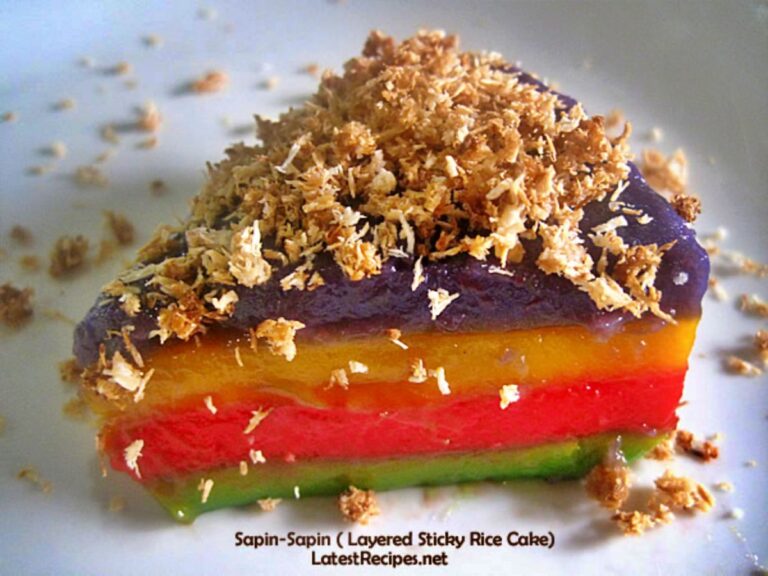
8) Sapin-Sapin
Sapin-Sapin is a vibrant Filipino dessert that catches your eye with its colorful layers. The name “Sapin-Sapin” means “layered” in Filipino, which is fitting for this dish.
You make Sapin-Sapin with a mixture of glutinous rice flour, coconut milk, condensed milk, and sugar. These ingredients create a smooth batter that you then divide into different parts.
Each part gets colored and flavored uniquely. Typically, the purple layer is flavored with ube, the yellow with jackfruit, and the plain white layer stays as is. You steam each layer separately, letting it set before adding the next one.
After steaming, you let it cool completely. You can then run a knife around the edges to loosen it and invert it onto a serving plate. Sometimes, Sapin-Sapin is topped with latik, which are caramelized coconut flakes.
This dessert not only looks appealing but also offers various flavors in each bite. It’s often served at celebrations and gatherings, making it a festive and delightful treat.
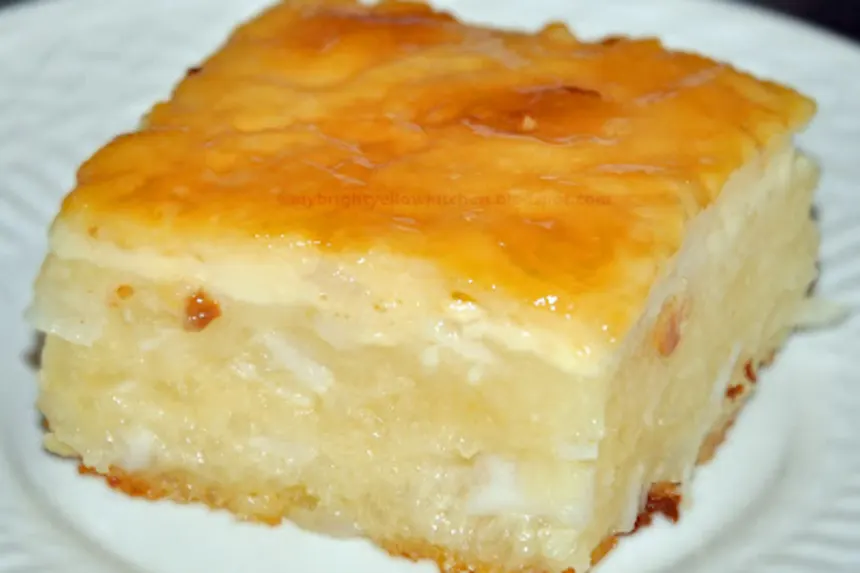
9) Cassava Cake
Cassava cake is a classic Filipino dessert that’s loved by many. Made from grated cassava, coconut milk, and condensed milk, it features a unique texture that’s both chewy and creamy.
To make cassava cake, you first need grated cassava. Fresh cassava has to be squeezed to remove excess liquid, while frozen cassava can be used directly.
Mix the grated cassava with butter, eggs, sugar, and evaporated milk. This combination creates a rich batter. Add coconut milk to the mixture for extra flavor and moisture.
Bake the batter in a preheated oven until it turns golden brown. The cake should be slightly puffy and set in the center. Be careful when removing it from the oven as it will be hot.
Consider spreading a layer of condensed milk on top of the baked cake for added sweetness. Some variations also include toppings like macapuno strings, adding a delightful texture.
Enjoy cassava cake warm or chilled. It’s a perfect treat for gatherings or simple family desserts. The combination of ingredients makes this dessert both rich and satisfying.
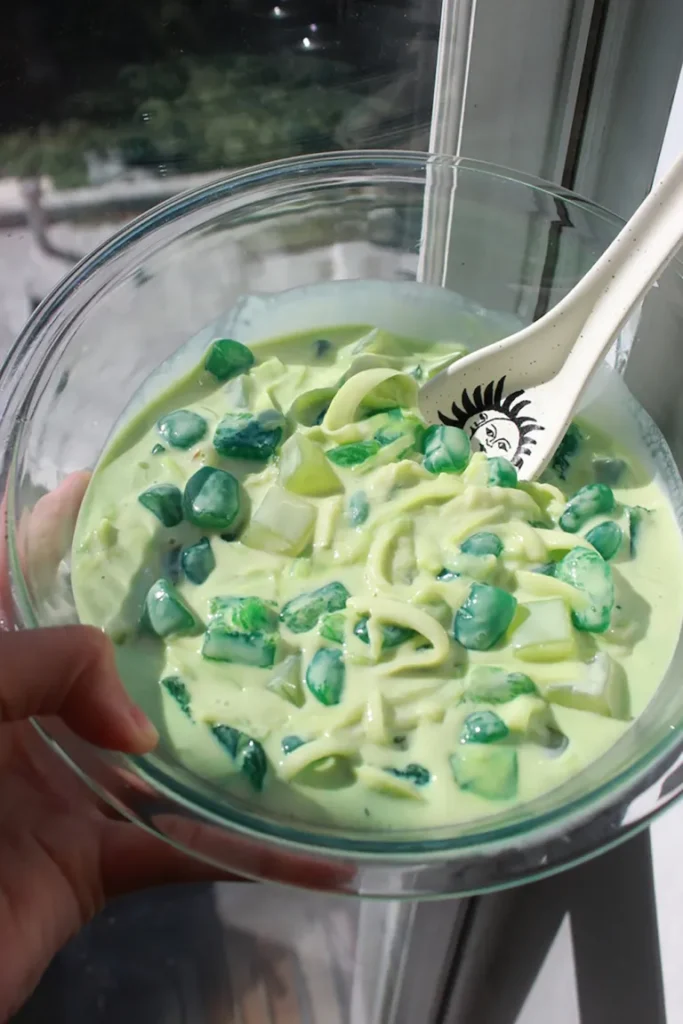
10) Buko Pandan
Buko Pandan is a refreshing Filipino dessert. It’s made with young coconut (buko) and sweetened pandan-flavored gelatin.
You start by boiling pandan leaves in water to extract their flavor. If you don’t have fresh pandan leaves, you can use pandan extract.
Gelatin cubes are prepared separately and added to the mixture.
Once the gelatin is set, it’s cut into small cubes. These are combined with shredded young coconut, condensed milk, and cream.
To complete the dish, small tapioca pearls or nata de coco are mixed in. Chill the mixture in the refrigerator until cold.
Serve Buko Pandan in cups or bowls. You can top it with a scoop of vanilla ice cream for an extra treat.
This dessert is perfect for hot days. It’s sweet, creamy, and has a unique aroma from the pandan leaves. It’s a popular choice for parties and special occasions in the Philippines.
Try making Buko Pandan for a taste of Filipino tradition. It’s a simple dessert that captures the essence of tropical flavors.
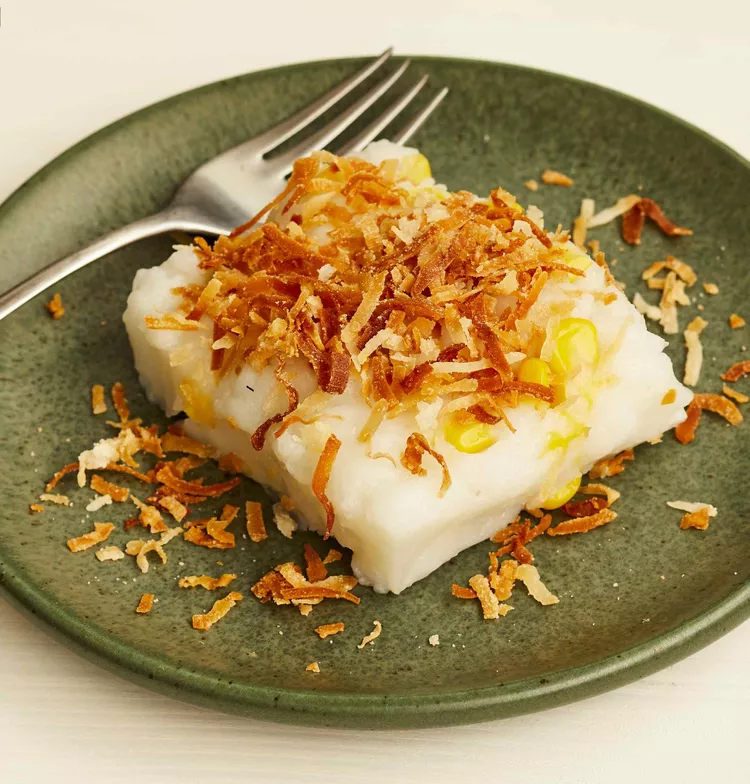
11) Maja Blanca
Maja Blanca is a traditional Filipino dessert made with coconut milk, cornstarch, and sugar. It is known for its creamy texture and light sweetness. This dessert is often served during special occasions and holidays.
To make Maja Blanca, you start by heating coconut milk in a pot until it reaches a gentle boil. Then, you add sugar, condensed milk, and whole sweet kernel corn. Stir the mixture to ensure that all the ingredients are well combined.
Next, you need to prepare the cornstarch mixture. Combine cornstarch with some cold water and mix until it is smooth. Slowly pour the cornstarch mixture into the pot of coconut milk, stirring constantly to prevent lumps from forming. Cook the mixture until it thickens.
Once thickened, pour the Maja Blanca mixture into a greased baking dish. Allow it to cool and set for a few hours in the refrigerator. When it is firm, top it with toasted coconut flakes for added texture and flavor. Some people also enjoy it with a sprinkle of shredded cheese.
Enjoy your Maja Blanca in small squares or slices. It’s a delightful treat that showcases the rich flavors of coconut and corn in a smooth, pudding-like consistency.

12) Yema
Yema is a popular Filipino candy made from a mixture of egg yolks and condensed milk. It has a rich, sweet taste and sticky, chewy texture.
To make yema, start by mixing egg yolks and condensed milk in a bowl. Some recipes suggest adding lime zest or vanilla for extra flavor.
Cook this mixture in a non-stick pan over low heat. Stir regularly to prevent it from burning. You may need to scrape the sides and bottom of the pan to keep it smooth.
Once the mixture thickens, let it cool. You can then shape it into balls. Some people like to coat these balls in sugar for a sweet crust.
For a more elaborate recipe, you can add chopped nuts. The nuts add a nice crunch to the sticky texture of the yema.
Yema spread is another version you might enjoy. You cook it the same way but stop once it reaches a spreadable consistency. This spread is perfect on bread or crackers.
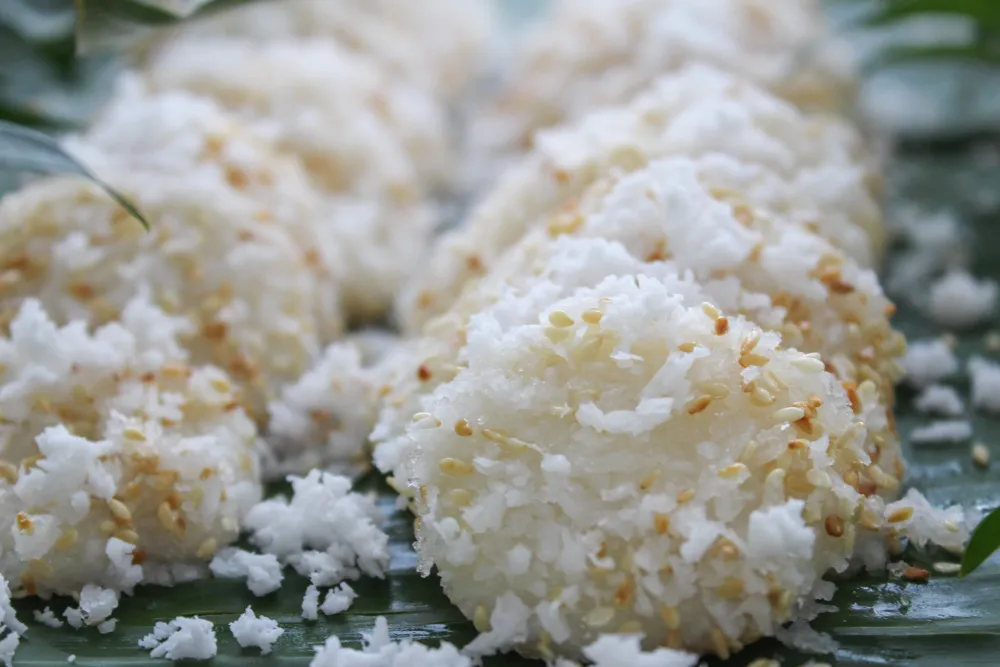
13) Palitaw
Palitaw is a classic Filipino dessert often enjoyed as a snack or treat. Its name comes from the Tagalog word “litaw,” meaning “to float.” This name refers to the cooking process, where the dough floats to the water’s surface.
To make Palitaw, you need glutinous rice flour and water. Mix these to form a smooth, pliable dough. Divide the dough into small pieces and flatten each piece with your hands.
Boil a pot of water and drop the flattened dough into it. When the dough pieces float, they are ready. Remove them with a slotted spoon and let them cool.
After cooling, roll the Palitaw in a mixture of sugar, grated coconut, and toasted sesame seeds. This simple yet delicious coating adds texture and sweetness to the chewy rice cakes.
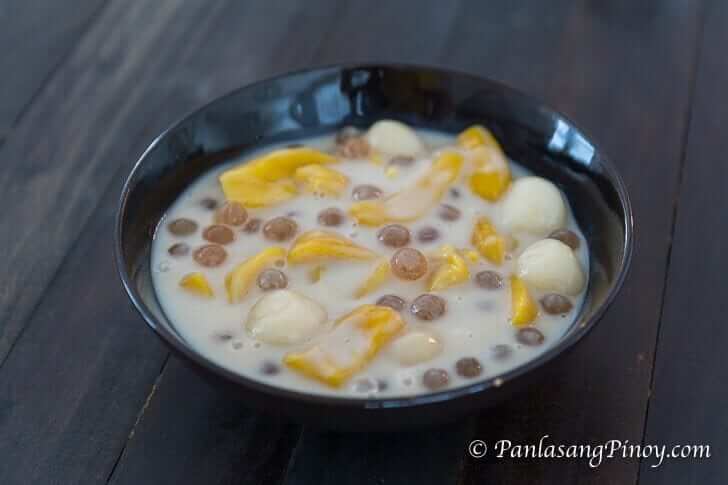
14) Ginataang Bilo-Bilo
Ginataang Bilo-Bilo is a popular Filipino dessert known for its creamy coconut milk base and chewy rice balls.
You start by making the bilo-bilo, which are sticky rice balls. Combine glutinous rice flour and water to form a dough, then roll small portions into balls using your palms.
Next, bring coconut milk and water to a simmer in a pot. Add sugar to sweeten the mixture.
You can add other ingredients like sweet potatoes, bananas, and jackfruit to the simmering coconut milk for added flavor and texture.
Cook tapioca pearls separately until they become translucent. Rinse and drain them well.
Combine the rice balls, tapioca pearls, and other fruits in the coconut milk mixture. Cook until the rice balls float and everything is well-blended.
This dessert can be served warm or chilled, depending on your preference. It’s a comforting treat that showcases the rich, tropical flavors of the Philippines.
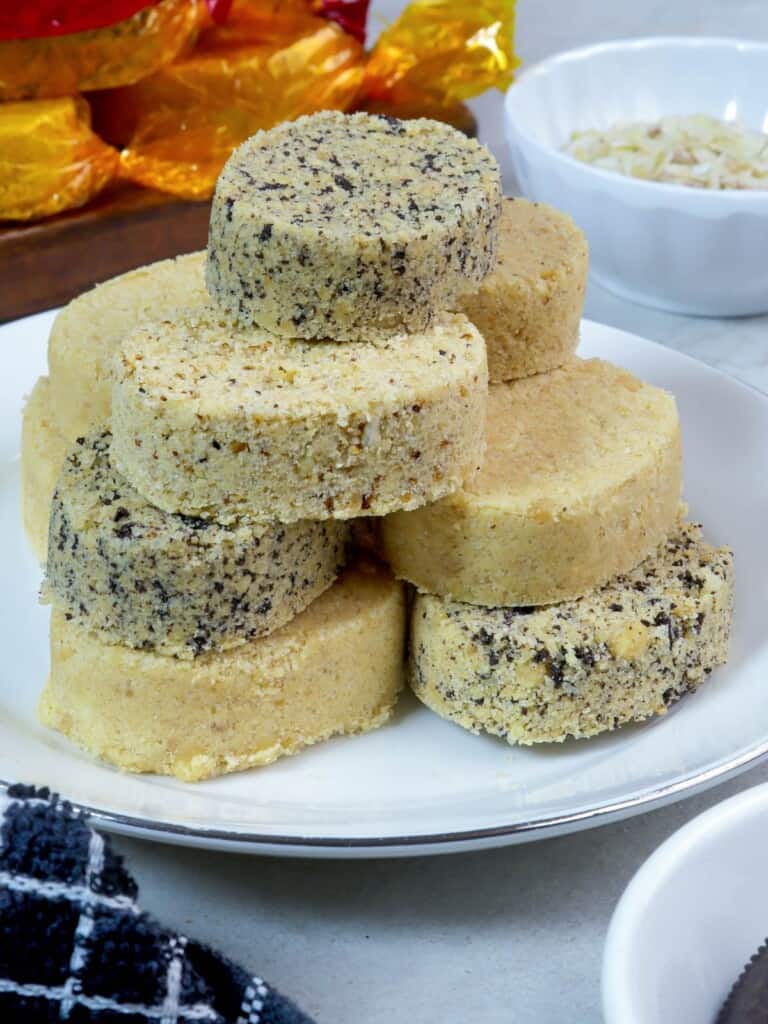
15) Polvoron
Polvoron is a popular Filipino shortbread cookie. It is made from toasted flour, powdered milk, butter, and sugar. These ingredients are mixed together until they form a crumbly mixture.
To make polvoron, you need to toast the flour until it turns light brown. This process gives the cookie a nutty flavor. Once the flour is toasted, let it cool down.
In a mixing bowl, combine the toasted flour with powdered milk and sugar. Mix them well so that all the ingredients are evenly distributed. Then, add the butter and stir until the mixture binds together.
You can add various flavors to polvoron. Some popular options include ground nuts, rice cereal, and crushed cookies. These add-ins can give the polvoron different textures and tastes.
To shape the polvoron, you will need a polvoron mold. Press the mixture into the mold to form solid cookies. Once you have shaped them, you can wrap each polvoron in colored cellophane or wax paper.
Polvoron is often enjoyed during holidays and special occasions. It is a simple and delicious treat that many people in the Philippines love.
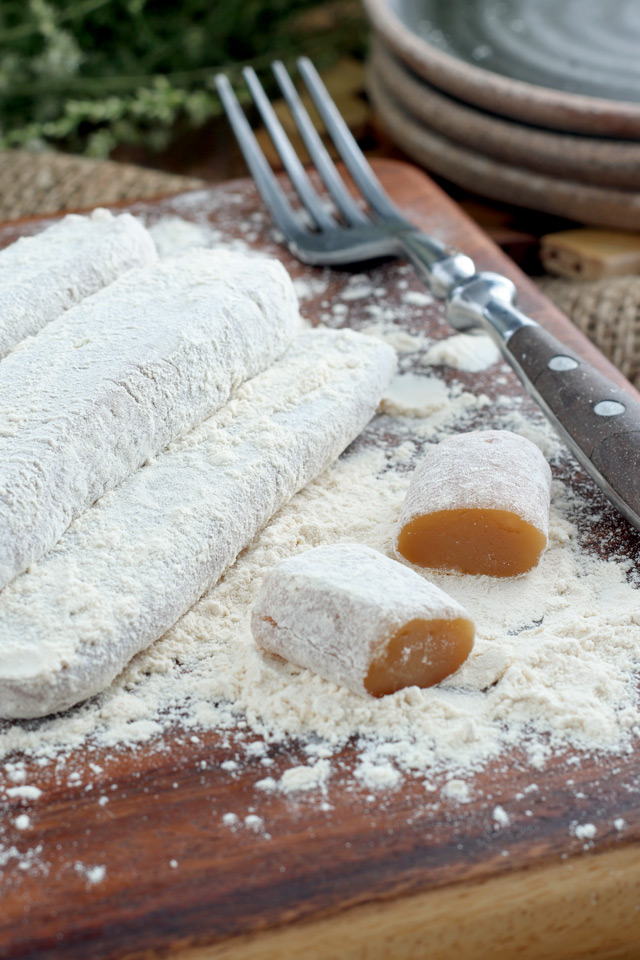
16) Espasol
Espasol is a popular Filipino rice cake made from toasted glutinous rice flour and coconut milk. It has a unique chewy texture and is coated with more toasted rice flour, giving it a distinct appearance.
To make Espasol, first, you need to toast the glutinous rice flour in a pan. Stir constantly until it turns a light brown color and releases a nutty aroma. This toasting process is crucial for the flavor.
In a separate pot, combine coconut milk and sugar. Bring the mixture to a boil, stirring until the sugar dissolves. Add vanilla extract and a pinch of salt for extra flavor.
Next, gradually add the toasted rice flour into the boiling mixture. Stir continuously to avoid lumps. Continue cooking and stirring until the mixture thickens and becomes hard to stir. This can take up to an hour.
Once the mixture is thick, let it cool slightly. Transfer it to a flat surface dusted with the reserved toasted rice flour. Shape the mixture into logs or your preferred shape, and coat them with more toasted rice flour.
Espasol is best enjoyed cool. It makes for a delightful snack or dessert that showcases traditional Filipino flavors.
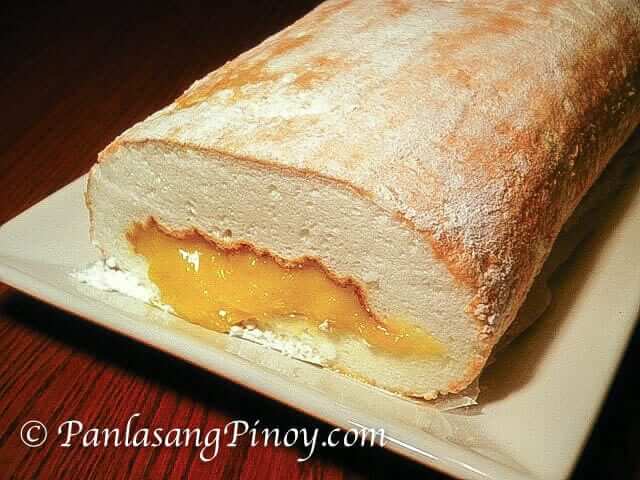
17) Brazo de Mercedes
Brazo de Mercedes is a popular Filipino dessert known for its light meringue and rich custard filling. It’s a rolled cake made primarily from egg whites, sugar, and a creamy custard.
To make the meringue, you will need egg whites and cream of tartar. These are whipped together until frothy and then sugar is gradually added.
The mixture is then spread onto a baking sheet lined with parchment paper and baked until golden brown.
For the filling, a custard made from egg yolks, condensed milk, and sometimes vanilla, is cooked over low heat until thick and spreadable.
Once the meringue has cooled, you spread the custard filling evenly over it.
Then, you carefully roll the meringue into a log shape, enclosing the custard inside.
Brazo de Mercedes is often served chilled and dusted with powdered sugar.
Its delicate flavor and texture make it a favorite in many Filipino households.
This dessert is a wonderful treat for special occasions or any time you want to enjoy a traditional Filipino sweet.
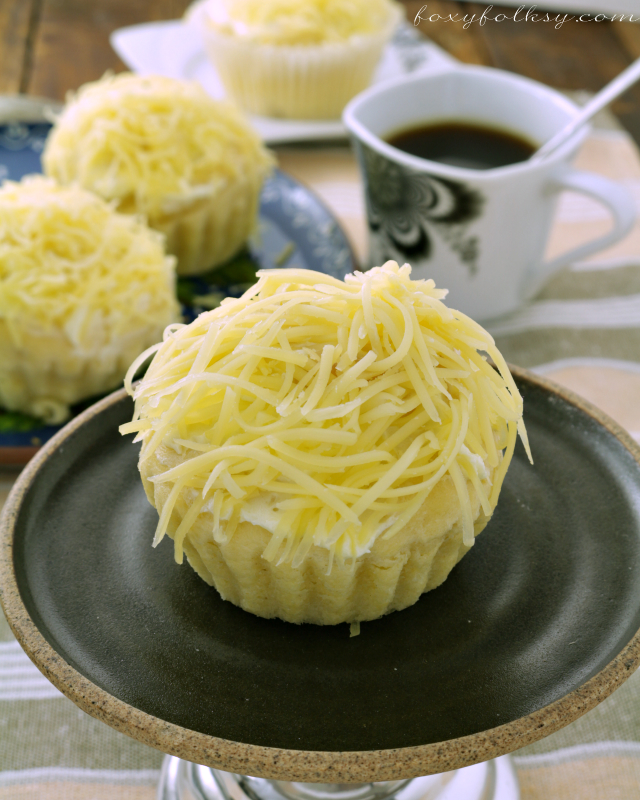
18) Cheese Ensaymada
Cheese Ensaymada is a classic Filipino pastry that’s a hit with cheese lovers. It’s a soft, fluffy bread that’s topped with a generous amount of butter, sugar, and grated cheese.
To make it, you first create a dough. This dough usually includes ingredients like milk, butter, sugar, salt, flour, egg yolks, and yeast.
Mix the ingredients until you achieve a smooth, paste-like consistency. Allow the dough to rise, which can take about an hour. Once it has risen, you can shape it into small rolls.
After shaping, let the dough rise again before baking. Bake until the Ensaymada turns golden brown, usually for about 18-20 minutes.
Once baked, brush the Ensaymada with softened butter. Then, sprinkle powdered sugar and top with grated cheese.
The result is a delicious, cheesy treat that’s perfect for any time of the day. Enjoy!
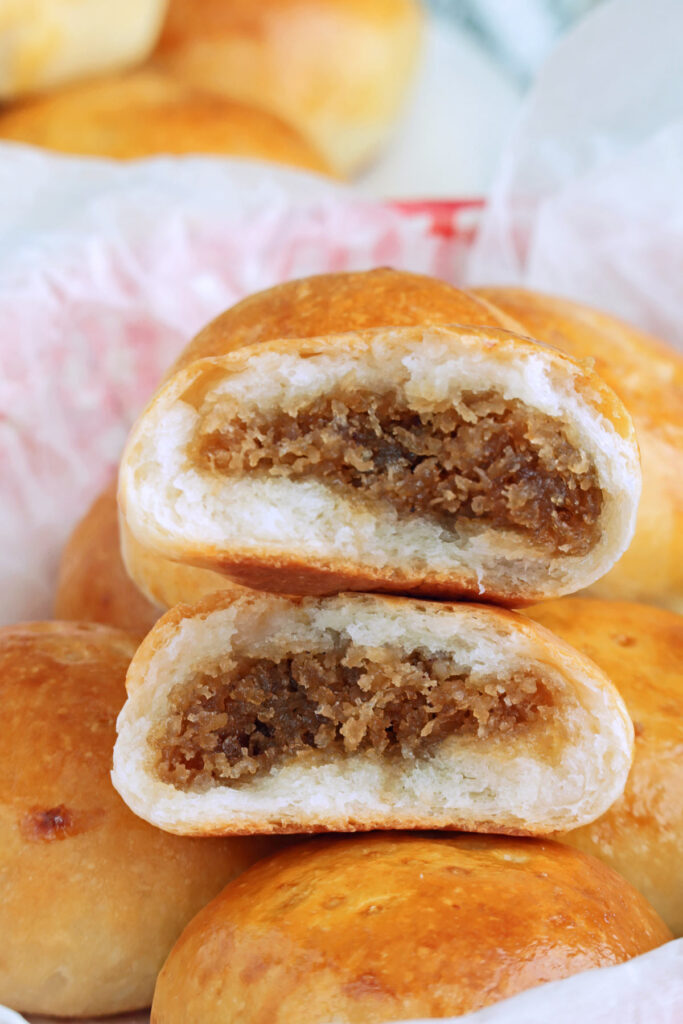
19) Pan de Coco
Pan de Coco is a popular Filipino bread filled with sweetened coconut.
First, you make the filling. Combine desiccated coconut, brown sugar, coconut milk, water, and butter in a pan. Simmer over low heat until the liquid is mostly absorbed. If you want a thicker filling, add a mixture of flour and milk.
Next, prepare the dough. In a bowl, mix flour, sugar, salt, and instant dry yeast. Add lukewarm milk, a bit of water, eggs, and butter or vegetable oil. Knead until it forms a smooth dough, then let it rise.
Divide the dough into small portions. Flatten each piece and fill with the coconut mixture. Seal the edges and shape into balls.
Place on a baking sheet and let them rise again. Preheat your oven to 350°F. Brush each roll with egg wash for a golden brown finish. Bake for about 20 minutes.
Serve warm. Pan de Coco pairs perfectly with coffee or hot chocolate. This bread is a delightful treat for breakfast or snacks.
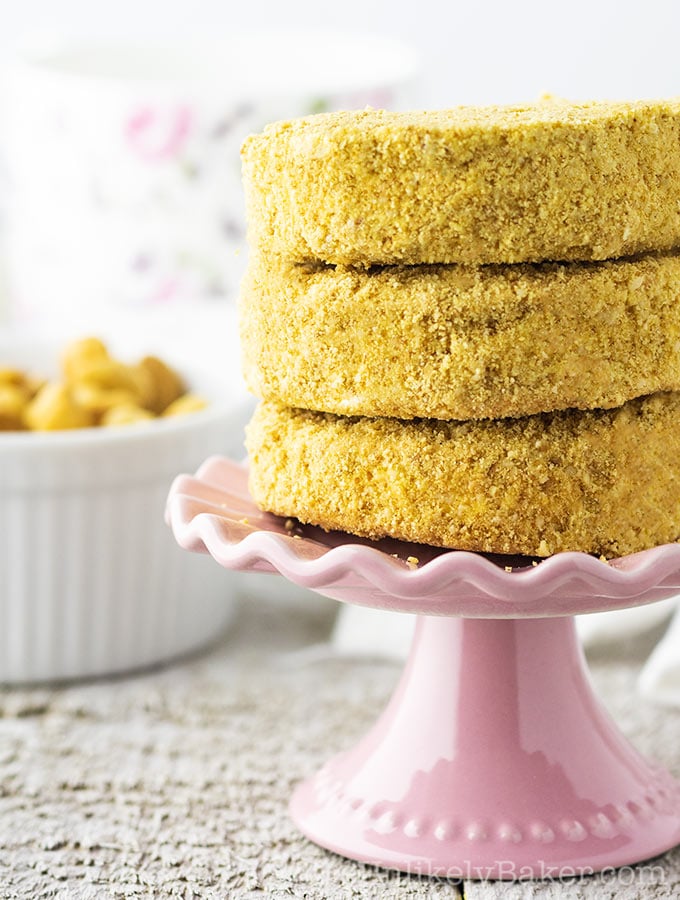
20) Silvanas
Silvanas are crispy, buttery cookies that are a treat from the Philippines. They come as a sandwich made with cashew-meringue cookies filled with rich buttercream. The outer layer is covered in biscuit crumbs, adding an extra crunch.
To make Silvanas, you start by preparing the meringue. Beat egg whites until foamy, then add cream of tartar and sugar. Once stiff peaks form, you mix in finely ground cashews.
Next, shape the meringue into small circles on a baking sheet lined with parchment paper. Bake them until they turn light golden brown. Once baked, let them cool completely before you handle them.
While the cookies cool, prepare your buttercream filling. You spread the buttercream on the flat side of one cookie and then sandwich it with another. Ensure the smooth sides are out for a neat finish.
Roll the sides of each sandwich in biscuit crumbs. This gives Silvanas their distinct texture and flavor. They are best served chilled, allowing the buttercream to firm up.
Make sure to store Silvanas in the refrigerator. This dessert offers a wonderful medley of textures and flavors that highlight Filipino sweets at their best.
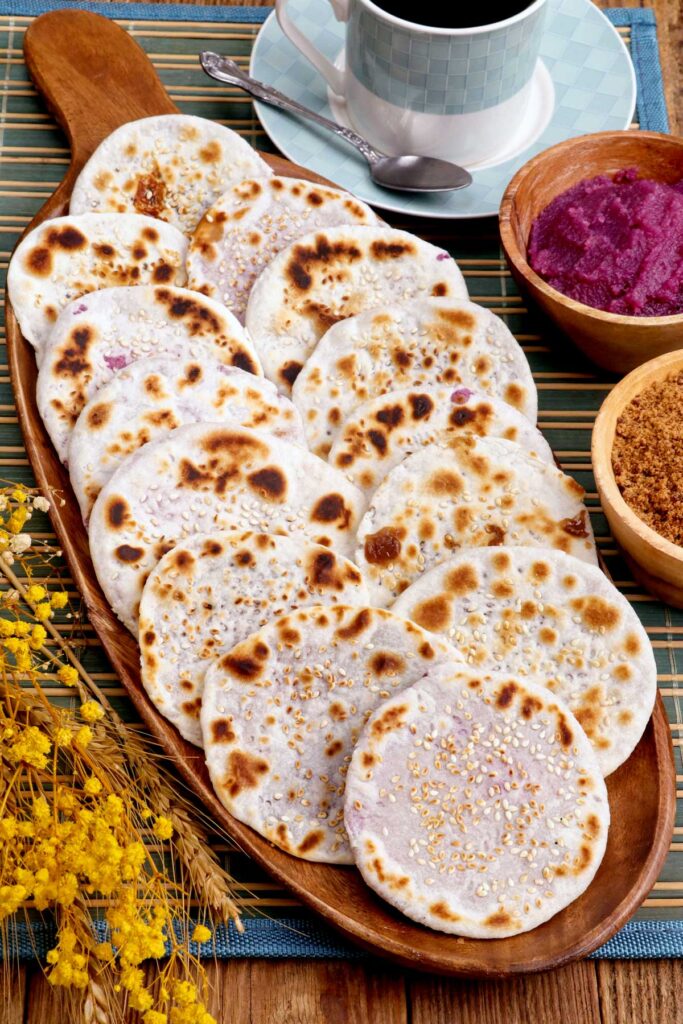
21) Piaya
Piaya is a sweet flatbread from the Philippines. It’s known for its distinct muscovado sugar filling. The dough is made from flour, water, and shortening or butter.
You flatten the dough and place a spoonful of filling in the center. Close the dough around the filling, then flatten it again.
Cooking piaya can be done on a low heat pan for even browning. This helps achieve the desired flakiness. For extra flavor, you can dip one side of the dough in sesame seeds before cooking.
Once cooked, piaya is usually golden brown and slightly crisp. It’s often enjoyed warm but can also be reheated if needed. These sweet treats make a perfect snack or dessert with a cup of tea or coffee.
Making piaya at home can be a fun and rewarding experience. You can experiment with different fillings like ube halaya for a unique twist on this traditional dessert.
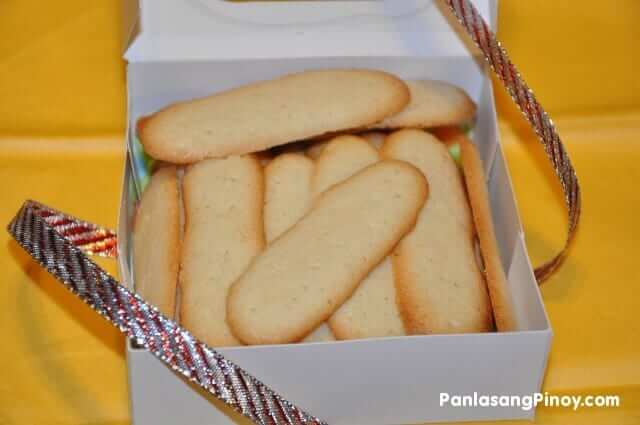
22) Lengua de Gato
Lengua de Gato is a popular Filipino butter cookie. Its name means “cat’s tongue” in Spanish, named for its thin and elongated shape. These cookies are light, buttery, and crisp, making them a favorite snack or gift item.
To make these cookies, you start by preheating your oven to 350°F and lining baking sheets with parchment paper. Then, cream butter and sugar until light and fluffy.
In a separate bowl, whisk together flour and a pinch of salt. Slowly add this to the butter mixture, followed by egg whites and vanilla extract, mixing until everything is well combined.
Using a piping bag fitted with a round tip, pipe the mixture onto the prepared baking sheets in long, thin strips. Bake for about 10-12 minutes until the edges turn golden brown. Let the cookies cool completely before handling.
Lengua de Gato pairs perfectly with coffee or tea. They are often packaged in tins and given as gifts during holidays and special occasions. These simple yet delightful cookies showcase the rich flavors of butter, making them a must-try for any dessert lover.
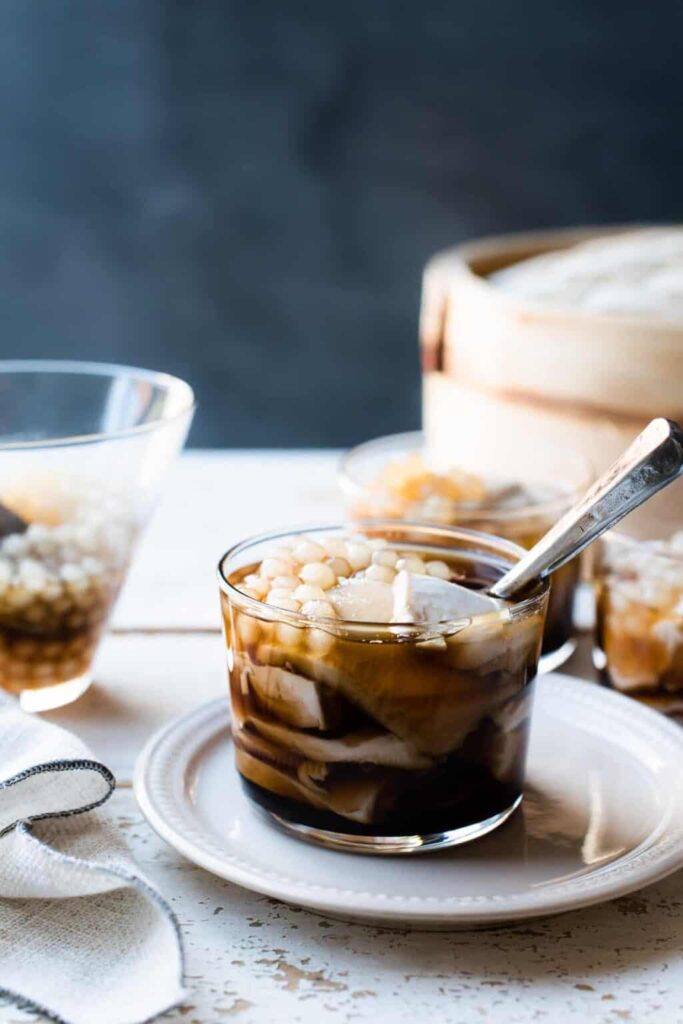
23) Taho
Taho is a popular Filipino street food made from silken tofu, arnibal (a sweet syrup), and sago pearls. You can find it being sold by street vendors early in the morning.
The silken tofu is steamed until it’s warm and soft. This gives it a smooth and creamy texture.
Arnibal is made by boiling brown sugar with a bit of vanilla extract. This syrup adds a rich, sweet flavor to the tofu.
Sago pearls are boiled until they become translucent and chewy. These pearls add a fun texture to the dessert.
To serve taho, you scoop warm tofu into a cup, pour arnibal over it, and add a spoonful of sago pearls on top. Enjoy it with a spoon or a straw.
Taho is not only delicious but also quick and easy to make at home. Try it for a simple and sweet treat.
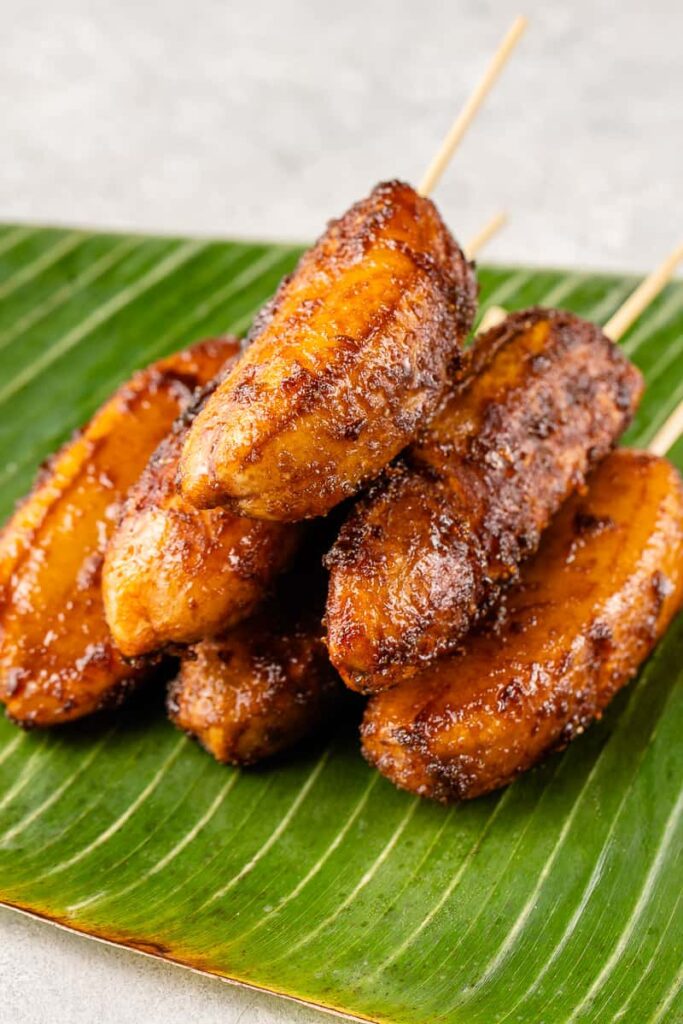
24) Banana Cue
Banana Cue is a popular Filipino street food that’s delicious and easy to make. It’s a dessert made by frying saba bananas and coating them in caramelized brown sugar.
To start, peel the saba bananas but keep them whole. Heat some oil in a pan until it’s warm. You don’t need too much oil, just enough to cover about half of the banana.
Next, add the brown sugar to the hot oil. Let the sugar melt and mix with the oil until it starts to turn a light amber color. This forms the caramel coating for the bananas.
Gently place the bananas into the pan. Fry them for about 2 minutes while making sure to turn them so each side gets an even coating of caramelized sugar. The bananas should become soft and the sugar should stick well to them.
Once done, take the bananas out of the oil and let them drain on paper towels. You can serve them on skewers for an authentic street food experience. Enjoy your Banana Cue hot while the sugar coating is still crisp.
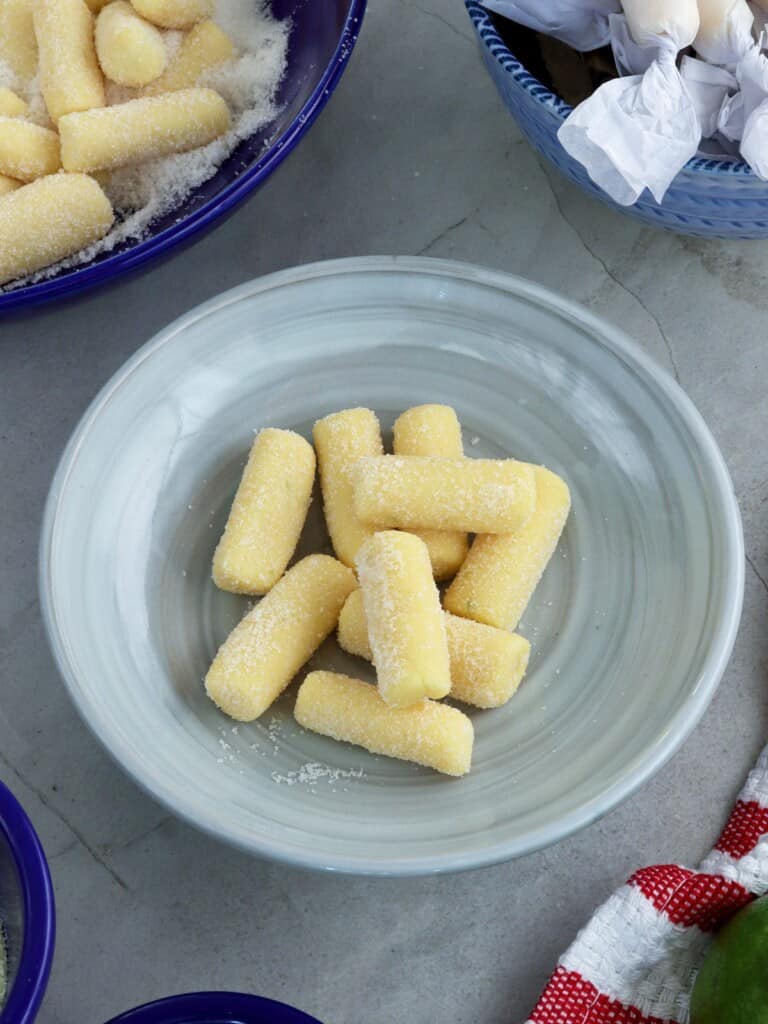
25) Pastillas de Leche
Pastillas de Leche are sweet milk candies from the Philippines. They are made from condensed milk and powdered milk, giving them a rich and creamy texture. These treats are popular for their simplicity and delicious taste.
To make Pastillas de Leche, you start by placing condensed milk in a bowl. Gradually fold in powdered milk until you get a dough-like consistency. This mixture is then shaped into small cylinders or logs.
Once shaped, the pastillas are rolled in granulated sugar. This adds a delightful crunch to every bite. Finally, they are wrapped in colorful paper or cellophane, making them visually appealing and perfect for gift-giving.
You can find Pastillas de Leche in many Filipino households during special occasions and holidays. They are a favorite among both children and adults, often served as a dessert or a snack. Enjoy making and sharing this classic Filipino treat!
History of Filipino Desserts
Filipino desserts have a rich history that reflects the country’s diverse cultural influences and agricultural bounty. These sweet treats have evolved over centuries, blending indigenous ingredients with foreign culinary traditions.
Origins and Cultural Significance
The origins of Filipino desserts are deeply tied to local ingredients like rice, coconut, and tropical fruits. Kakanin, a type of rice cake, has been a staple for celebrations and rituals for centuries. Desserts like suman and puto use sticky rice, emphasizing the importance of rice in Filipino culture.
Colonial influences also played a significant role. The Spanish introduced desserts such as leche flan and polvoron, while the Americans brought innovations like gelatin and ice cream. These foreign elements were adapted to local tastes, creating unique Filipino versions.
Evolution Over Time
Over the years, Filipino desserts have continued to evolve. Modern technology and globalization have introduced new ingredients and techniques. Traditional cooking methods, such as steaming in banana leaves, coexist with contemporary baking and refrigeration methods.
The fusion of flavors is a hallmark of this evolution. For example, halo-halo (a popular shaved ice dessert) combines various ingredients like fruits, beans, and jelly, showcasing the blend of different cultural influences. Today, Filipino desserts are enjoyed both in the Philippines and around the world, evolving to meet changing tastes while preserving their rich heritage.
Key Ingredients in Filipino Desserts
Filipino desserts are known for their rich flavors and unique combinations. You will often find a variety of local fruits, sweeteners, and flavorings that are key to these delicious treats.
Commonly Used Fruits
Fruits play a crucial role in Filipino desserts. Mangoes are widely loved for their sweetness and are often used fresh or in jams. Bananas are another staple; they are used in various forms such as banana chips or in deep-fried dishes like Turon.
Jackfruit is also popular, adding a distinct taste and texture to recipes like Halo-Halo. For a hint of exotic flavor, pandan leaves are sometimes added, especially in desserts like Buko Pandan. These fruits provide natural sweetness and vibrant colors that make the desserts visually appealing and mouth-watering.
Unique Sweeteners and Flavorings
The sweeteners and flavorings used in Filipino desserts are often what make these treats stand out. Coconut milk and coconut cream are essentials, offering a rich and creamy base for many recipes such as Biko and Suman.
Brown sugar and palm sugar are commonly used for their deep, molasses-like sweetness. Ube (purple yam) is a unique ingredient that lends an eye-catching color and a subtle, nutty flavor to desserts like Ube Halaya.
Condensed milk is frequently drizzled over shaved ice in Halo-Halo or mixed into flans and leche plan for an extra layer of sweetness. These ingredients not only add sweetness but also contribute to the distinctive taste profiles of Filipino desserts.


